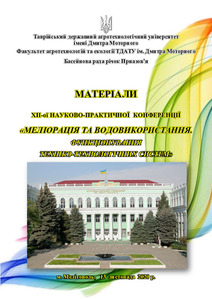Please use this identifier to cite or link to this item:
http://elar.tsatu.edu.ua/handle/123456789/12420Full metadata record
| DC Field | Value | Language |
|---|---|---|
| dc.contributor.author | Антоновський, Олександр Григорович | - |
| dc.contributor.author | Антоновский, Александр Григорьевич | - |
| dc.contributor.author | Antonovskyi, Oleksandr | - |
| dc.contributor.author | Ткаченко, В. В. | - |
| dc.contributor.author | Онофраш, К. | - |
| dc.date.accessioned | 2020-11-25T10:36:27Z | - |
| dc.date.available | 2020-11-25T10:36:27Z | - |
| dc.date.issued | 2020 | - |
| dc.identifier.uri | http://elar.tsatu.edu.ua/handle/123456789/12420 | - |
| dc.description.abstract | UK: Ми встановили, що у 2019 р. за кількісними показниками макрозообентосу найпродуктивнішими були ділянки вздовж Бердянської коси. Серед усіх досліджуваних ділянок найбільше біорізноманіття ми спостерігали в Азовському морі на оголовку Бердянської коси та в Бердянській затоці. Серед лиманів ми відмічали найбільше біорізноманіття в оз. Сивашик (26 таксонів). Протягом минулого року Молочний лиман залишався без стабільного сполучення з Азовським морем, тому його солоність трималась на рівні 80-120‰. Збіднілу фауну ми спостерігали наприкінці квітня-початку травня, коли кількість таксонів виявлених безхребетних складала 2: артемії та личинки хірономід. Обстеження окремих ділянок Азовського моря показало зменшення кількості видів та зростання біомаси виявлених видів порівняно до минулих років. Найвищі показники щільності, біомаси та біорізноманіття були виявлені у прибережних ділянках Бердянської коси. Так, на оголовку виявили 50 таксонів донних безхребетних, біомаса зообентосу складала 669,213 г∙м-2. Щільність поселень макрозообентосу на оголовку коси сягала 58047 орг.∙м-2. EN: We found that in 2019, according to the quantitative indicators of macrozoobenthos, the most productive areas were along the Berdyansk spit. Among all the studied areas, we observed the greatest biodiversity in the Sea of Azov at the head of the Berdyansk spit and in the Berdyansk Bay. Among the estuaries, we noted the greatest biodiversity in the lake Sivashik (26 taxa). During the last year, the Molochnyy liman remained without a stable connection with the Sea of Azov, so its salinity remained at the level of 80-120 ‰. We observed the impoverished fauna in late April-early May, when the number of taxa of the detected invertebrates was 2: Artemia salina and Chironomus sp. The survey of some parts of the Sea of Azov showed a decrease in the number of species and an increase in the biomass of the identified species compared to previous years. The highest indicators of density, biomass and biodiversity were found in the coastal areas of Berdyansk Spit. Thus, 50 taxa of benthic invertebrates were found on the head, the biomass of zoobenthos was 669.213 g ∙ m-2. The density of macrozoobenthos on the head of the spit reached 58047 org. ∙ m-2. | uk |
| dc.language.iso | uk | uk |
| dc.publisher | ТДАТУ | uk |
| dc.relation.ispartofseries | Меліорація та водовикористання. Функціонування техніко-технологічних систем: матеріали ХІI-ої науково-практичної конференції (Мелітополь, 13 листопада 2020 р.);С. 61-64 | - |
| dc.subject | Приазовський НПП | uk |
| dc.subject | Азовське море | uk |
| dc.subject | Молочний лиман | uk |
| dc.subject | зообентос | uk |
| dc.subject | щільність | uk |
| dc.subject | біомаса | uk |
| dc.subject | видове багатство | uk |
| dc.subject | молюски | uk |
| dc.subject | багатощетинкові черви | uk |
| dc.subject | ракоподібні | uk |
| dc.subject | Priazovsky National Park | uk |
| dc.subject | Sea of Azov | uk |
| dc.subject | Molochnyy liman | uk |
| dc.subject | zoobenthos | uk |
| dc.subject | density | uk |
| dc.subject | biomass | uk |
| dc.subject | species of richness | uk |
| dc.subject | mollusks | uk |
| dc.subject | polychaete worms | uk |
| dc.subject | crustaceans | uk |
| dc.title | Результати досліджень макрозообентосу в акваторіях Приазовського НПП у 2019 році | uk |
| dc.title.alternative | Results of research of macrozobenthose in the water areas of Prizovsk NNP in 2019 | uk |
| dc.type | Article | uk |
| Appears in Collections: | Кафедра Геоекологія та землеустрій | |
Files in This Item:
| File | Description | Size | Format | |
|---|---|---|---|---|
| 11. Результати дослідження макрозообентосу в акваторіях Приазовського НПП у 2019 році.pdf | 2.36 MB | Adobe PDF |  View/Open |
Show simple item record
CORE Recommender
???jsp.display-item.check???
Items in DSpace are protected by copyright, with all rights reserved, unless otherwise indicated.
